David's Astronomy Pages
Notes - Session 1047 (2022-10-14)
Notes
(S1046)
Notes
Main
Home
Page
Notes
(S1048)
David's Astronomy Pages
|
Notes (S1046) |
Notes Main |
Home Page |
Notes (S1048) |
Main aims
Equipment & Software
Highlights
Summary Plots & Logs
| Observing Plan | ||||||||||||||||||||||||||||||||||||||||||||||||||||||||||||||||||||||||||||||||||||||||||||||||||||||||||||||||||||||||||||||||||||||||||||||||||||||||||||||||||||||||||||||||||||||||||||||||||||||||||||||||||||||||||||||||||||||||||||||||||||||||||||||||||||||||||||||||||||||||||||||||||||||||||||||||||||||||||||||||||||||||||||||||||||||||||||||||||||||||||||||||||||||||||||||||||||||||||||||||||||||||||||||||||||||||||||||||||||||||||||||||||||||||||||||||||||||||||||||||||||||||||||||||||||||||||||||||||||||||||||||||||||||||||||||||||||||||||||||||||||||||||||||||
 |
||||||||||||||||||||||||||||||||||||||||||||||||||||||||||||||||||||||||||||||||||||||||||||||||||||||||||||||||||||||||||||||||||||||||||||||||||||||||||||||||||||||||||||||||||||||||||||||||||||||||||||||||||||||||||||||||||||||||||||||||||||||||||||||||||||||||||||||||||||||||||||||||||||||||||||||||||||||||||||||||||||||||||||||||||||||||||||||||||||||||||||||||||||||||||||||||||||||||||||||||||||||||||||||||||||||||||||||||||||||||||||||||||||||||||||||||||||||||||||||||||||||||||||||||||||||||||||||||||||||||||||||||||||||||||||||||||||||||||||||||||||||||||||||||
|
Observing Result |
||||||||||||||||||||||||||||||||||||||||||||||||||||||||||||||||||||||||||||||||||||||||||||||||||||||||||||||||||||||||||||||||||||||||||||||||||||||||||||||||||||||||||||||||||||||||||||||||||||||||||||||||||||||||||||||||||||||||||||||||||||||||||||||||||||||||||||||||||||||||||||||||||||||||||||||||||||||||||||||||||||||||||||||||||||||||||||||||||||||||||||||||||||||||||||||||||||||||||||||||||||||||||||||||||||||||||||||||||||||||||||||||||||||||||||||||||||||||||||||||||||||||||||||||||||||||||||||||||||||||||||||||||||||||||||||||||||||||||||||||||||||||||||||||
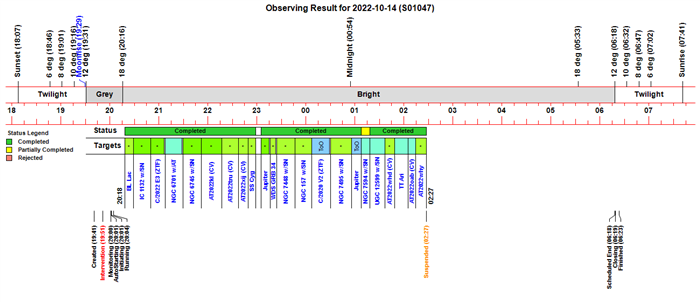 |
||||||||||||||||||||||||||||||||||||||||||||||||||||||||||||||||||||||||||||||||||||||||||||||||||||||||||||||||||||||||||||||||||||||||||||||||||||||||||||||||||||||||||||||||||||||||||||||||||||||||||||||||||||||||||||||||||||||||||||||||||||||||||||||||||||||||||||||||||||||||||||||||||||||||||||||||||||||||||||||||||||||||||||||||||||||||||||||||||||||||||||||||||||||||||||||||||||||||||||||||||||||||||||||||||||||||||||||||||||||||||||||||||||||||||||||||||||||||||||||||||||||||||||||||||||||||||||||||||||||||||||||||||||||||||||||||||||||||||||||||||||||||||||||||
| Dome & Scope Slewing Performance | ||||||||||||||||||||||||||||||||||||||||||||||||||||||||||||||||||||||||||||||||||||||||||||||||||||||||||||||||||||||||||||||||||||||||||||||||||||||||||||||||||||||||||||||||||||||||||||||||||||||||||||||||||||||||||||||||||||||||||||||||||||||||||||||||||||||||||||||||||||||||||||||||||||||||||||||||||||||||||||||||||||||||||||||||||||||||||||||||||||||||||||||||||||||||||||||||||||||||||||||||||||||||||||||||||||||||||||||||||||||||||||||||||||||||||||||||||||||||||||||||||||||||||||||||||||||||||||||||||||||||||||||||||||||||||||||||||||||||||||||||||||||||||||||||
 |
||||||||||||||||||||||||||||||||||||||||||||||||||||||||||||||||||||||||||||||||||||||||||||||||||||||||||||||||||||||||||||||||||||||||||||||||||||||||||||||||||||||||||||||||||||||||||||||||||||||||||||||||||||||||||||||||||||||||||||||||||||||||||||||||||||||||||||||||||||||||||||||||||||||||||||||||||||||||||||||||||||||||||||||||||||||||||||||||||||||||||||||||||||||||||||||||||||||||||||||||||||||||||||||||||||||||||||||||||||||||||||||||||||||||||||||||||||||||||||||||||||||||||||||||||||||||||||||||||||||||||||||||||||||||||||||||||||||||||||||||||||||||||||||||
| Slew/Centering Performance | ||||||||||||||||||||||||||||||||||||||||||||||||||||||||||||||||||||||||||||||||||||||||||||||||||||||||||||||||||||||||||||||||||||||||||||||||||||||||||||||||||||||||||||||||||||||||||||||||||||||||||||||||||||||||||||||||||||||||||||||||||||||||||||||||||||||||||||||||||||||||||||||||||||||||||||||||||||||||||||||||||||||||||||||||||||||||||||||||||||||||||||||||||||||||||||||||||||||||||||||||||||||||||||||||||||||||||||||||||||||||||||||||||||||||||||||||||||||||||||||||||||||||||||||||||||||||||||||||||||||||||||||||||||||||||||||||||||||||||||||||||||||||||||||||
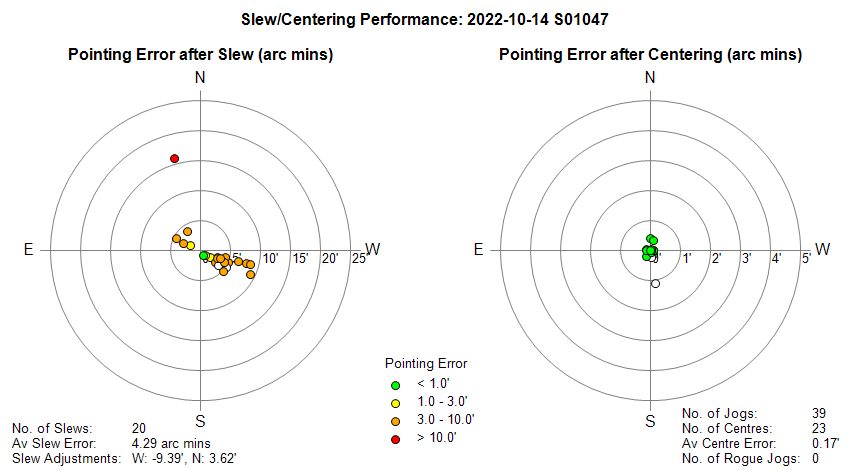 |
||||||||||||||||||||||||||||||||||||||||||||||||||||||||||||||||||||||||||||||||||||||||||||||||||||||||||||||||||||||||||||||||||||||||||||||||||||||||||||||||||||||||||||||||||||||||||||||||||||||||||||||||||||||||||||||||||||||||||||||||||||||||||||||||||||||||||||||||||||||||||||||||||||||||||||||||||||||||||||||||||||||||||||||||||||||||||||||||||||||||||||||||||||||||||||||||||||||||||||||||||||||||||||||||||||||||||||||||||||||||||||||||||||||||||||||||||||||||||||||||||||||||||||||||||||||||||||||||||||||||||||||||||||||||||||||||||||||||||||||||||||||||||||||||
| Guiding Performance | ||||||||||||||||||||||||||||||||||||||||||||||||||||||||||||||||||||||||||||||||||||||||||||||||||||||||||||||||||||||||||||||||||||||||||||||||||||||||||||||||||||||||||||||||||||||||||||||||||||||||||||||||||||||||||||||||||||||||||||||||||||||||||||||||||||||||||||||||||||||||||||||||||||||||||||||||||||||||||||||||||||||||||||||||||||||||||||||||||||||||||||||||||||||||||||||||||||||||||||||||||||||||||||||||||||||||||||||||||||||||||||||||||||||||||||||||||||||||||||||||||||||||||||||||||||||||||||||||||||||||||||||||||||||||||||||||||||||||||||||||||||||||||||||||
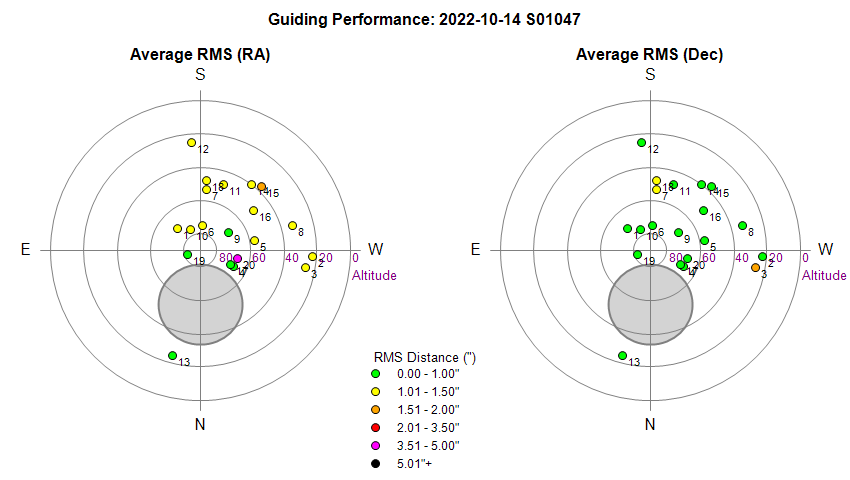 |
||||||||||||||||||||||||||||||||||||||||||||||||||||||||||||||||||||||||||||||||||||||||||||||||||||||||||||||||||||||||||||||||||||||||||||||||||||||||||||||||||||||||||||||||||||||||||||||||||||||||||||||||||||||||||||||||||||||||||||||||||||||||||||||||||||||||||||||||||||||||||||||||||||||||||||||||||||||||||||||||||||||||||||||||||||||||||||||||||||||||||||||||||||||||||||||||||||||||||||||||||||||||||||||||||||||||||||||||||||||||||||||||||||||||||||||||||||||||||||||||||||||||||||||||||||||||||||||||||||||||||||||||||||||||||||||||||||||||||||||||||||||||||||||||
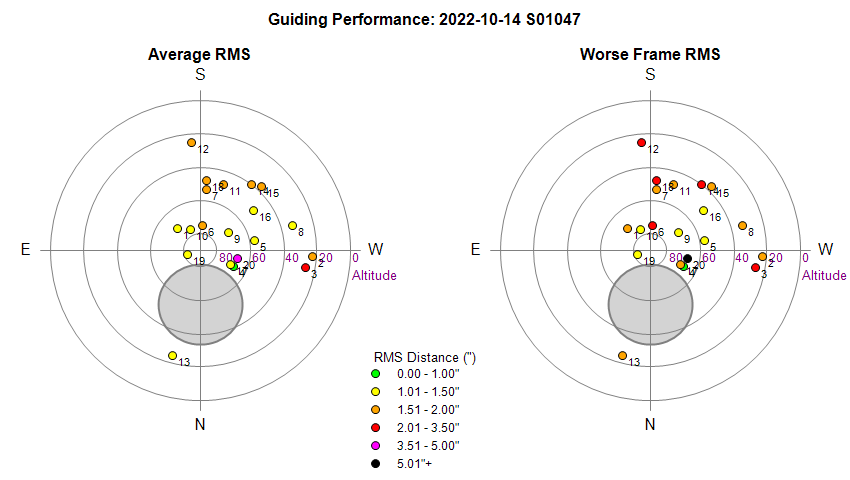 |
||||||||||||||||||||||||||||||||||||||||||||||||||||||||||||||||||||||||||||||||||||||||||||||||||||||||||||||||||||||||||||||||||||||||||||||||||||||||||||||||||||||||||||||||||||||||||||||||||||||||||||||||||||||||||||||||||||||||||||||||||||||||||||||||||||||||||||||||||||||||||||||||||||||||||||||||||||||||||||||||||||||||||||||||||||||||||||||||||||||||||||||||||||||||||||||||||||||||||||||||||||||||||||||||||||||||||||||||||||||||||||||||||||||||||||||||||||||||||||||||||||||||||||||||||||||||||||||||||||||||||||||||||||||||||||||||||||||||||||||||||||||||||||||||
| Sky Conditions (Locate Frames) | ||||||||||||||||||||||||||||||||||||||||||||||||||||||||||||||||||||||||||||||||||||||||||||||||||||||||||||||||||||||||||||||||||||||||||||||||||||||||||||||||||||||||||||||||||||||||||||||||||||||||||||||||||||||||||||||||||||||||||||||||||||||||||||||||||||||||||||||||||||||||||||||||||||||||||||||||||||||||||||||||||||||||||||||||||||||||||||||||||||||||||||||||||||||||||||||||||||||||||||||||||||||||||||||||||||||||||||||||||||||||||||||||||||||||||||||||||||||||||||||||||||||||||||||||||||||||||||||||||||||||||||||||||||||||||||||||||||||||||||||||||||||||||||||||
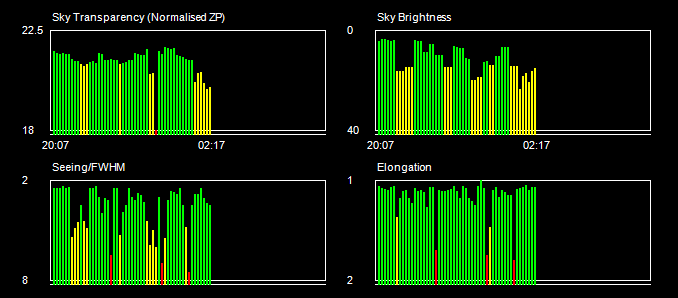 |
||||||||||||||||||||||||||||||||||||||||||||||||||||||||||||||||||||||||||||||||||||||||||||||||||||||||||||||||||||||||||||||||||||||||||||||||||||||||||||||||||||||||||||||||||||||||||||||||||||||||||||||||||||||||||||||||||||||||||||||||||||||||||||||||||||||||||||||||||||||||||||||||||||||||||||||||||||||||||||||||||||||||||||||||||||||||||||||||||||||||||||||||||||||||||||||||||||||||||||||||||||||||||||||||||||||||||||||||||||||||||||||||||||||||||||||||||||||||||||||||||||||||||||||||||||||||||||||||||||||||||||||||||||||||||||||||||||||||||||||||||||||||||||||||
|
Night Sky Summary Plot Top axis: Sky Brightness at Zenith (in ADU/s) Lefthand axis: Local Time (hh LT). Righthand axis: Sun Altitude (degs) |
||||||||||||||||||||||||||||||||||||||||||||||||||||||||||||||||||||||||||||||||||||||||||||||||||||||||||||||||||||||||||||||||||||||||||||||||||||||||||||||||||||||||||||||||||||||||||||||||||||||||||||||||||||||||||||||||||||||||||||||||||||||||||||||||||||||||||||||||||||||||||||||||||||||||||||||||||||||||||||||||||||||||||||||||||||||||||||||||||||||||||||||||||||||||||||||||||||||||||||||||||||||||||||||||||||||||||||||||||||||||||||||||||||||||||||||||||||||||||||||||||||||||||||||||||||||||||||||||||||||||||||||||||||||||||||||||||||||||||||||||||||||||||||||||
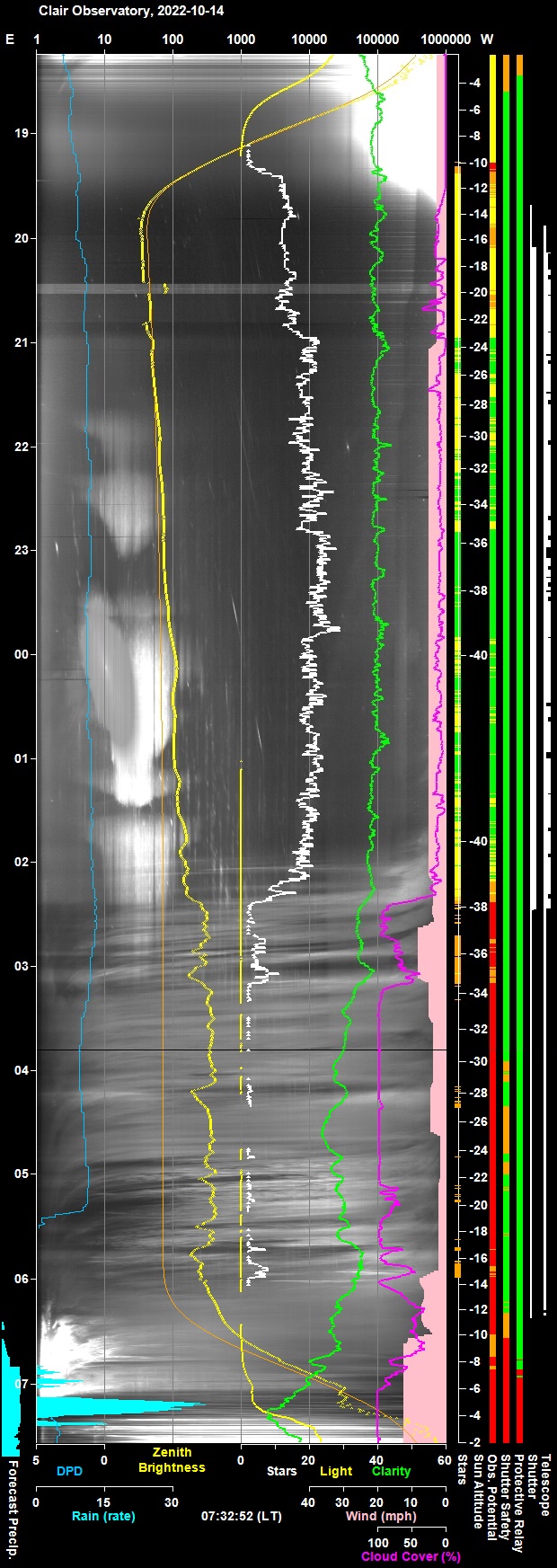 |
||||||||||||||||||||||||||||||||||||||||||||||||||||||||||||||||||||||||||||||||||||||||||||||||||||||||||||||||||||||||||||||||||||||||||||||||||||||||||||||||||||||||||||||||||||||||||||||||||||||||||||||||||||||||||||||||||||||||||||||||||||||||||||||||||||||||||||||||||||||||||||||||||||||||||||||||||||||||||||||||||||||||||||||||||||||||||||||||||||||||||||||||||||||||||||||||||||||||||||||||||||||||||||||||||||||||||||||||||||||||||||||||||||||||||||||||||||||||||||||||||||||||||||||||||||||||||||||||||||||||||||||||||||||||||||||||||||||||||||||||||||||||||||||||
|
Actual Weather vs Pre-Session Weather Forecast |
||||||||||||||||||||||||||||||||||||||||||||||||||||||||||||||||||||||||||||||||||||||||||||||||||||||||||||||||||||||||||||||||||||||||||||||||||||||||||||||||||||||||||||||||||||||||||||||||||||||||||||||||||||||||||||||||||||||||||||||||||||||||||||||||||||||||||||||||||||||||||||||||||||||||||||||||||||||||||||||||||||||||||||||||||||||||||||||||||||||||||||||||||||||||||||||||||||||||||||||||||||||||||||||||||||||||||||||||||||||||||||||||||||||||||||||||||||||||||||||||||||||||||||||||||||||||||||||||||||||||||||||||||||||||||||||||||||||||||||||||||||||||||||||||
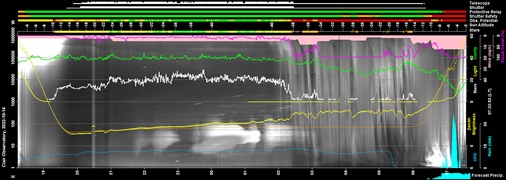 |
||||||||||||||||||||||||||||||||||||||||||||||||||||||||||||||||||||||||||||||||||||||||||||||||||||||||||||||||||||||||||||||||||||||||||||||||||||||||||||||||||||||||||||||||||||||||||||||||||||||||||||||||||||||||||||||||||||||||||||||||||||||||||||||||||||||||||||||||||||||||||||||||||||||||||||||||||||||||||||||||||||||||||||||||||||||||||||||||||||||||||||||||||||||||||||||||||||||||||||||||||||||||||||||||||||||||||||||||||||||||||||||||||||||||||||||||||||||||||||||||||||||||||||||||||||||||||||||||||||||||||||||||||||||||||||||||||||||||||||||||||||||||||||||||
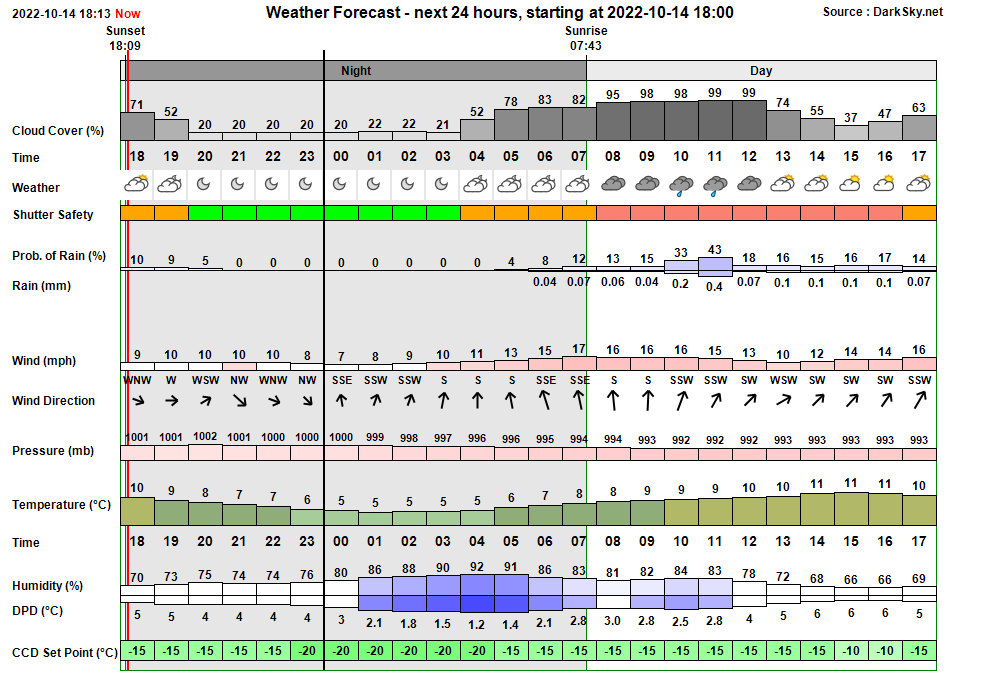 |
||||||||||||||||||||||||||||||||||||||||||||||||||||||||||||||||||||||||||||||||||||||||||||||||||||||||||||||||||||||||||||||||||||||||||||||||||||||||||||||||||||||||||||||||||||||||||||||||||||||||||||||||||||||||||||||||||||||||||||||||||||||||||||||||||||||||||||||||||||||||||||||||||||||||||||||||||||||||||||||||||||||||||||||||||||||||||||||||||||||||||||||||||||||||||||||||||||||||||||||||||||||||||||||||||||||||||||||||||||||||||||||||||||||||||||||||||||||||||||||||||||||||||||||||||||||||||||||||||||||||||||||||||||||||||||||||||||||||||||||||||||||||||||||||
| Session Event Log | ||||||||||||||||||||||||||||||||||||||||||||||||||||||||||||||||||||||||||||||||||||||||||||||||||||||||||||||||||||||||||||||||||||||||||||||||||||||||||||||||||||||||||||||||||||||||||||||||||||||||||||||||||||||||||||||||||||||||||||||||||||||||||||||||||||||||||||||||||||||||||||||||||||||||||||||||||||||||||||||||||||||||||||||||||||||||||||||||||||||||||||||||||||||||||||||||||||||||||||||||||||||||||||||||||||||||||||||||||||||||||||||||||||||||||||||||||||||||||||||||||||||||||||||||||||||||||||||||||||||||||||||||||||||||||||||||||||||||||||||||||||||||||||||||
|
||||||||||||||||||||||||||||||||||||||||||||||||||||||||||||||||||||||||||||||||||||||||||||||||||||||||||||||||||||||||||||||||||||||||||||||||||||||||||||||||||||||||||||||||||||||||||||||||||||||||||||||||||||||||||||||||||||||||||||||||||||||||||||||||||||||||||||||||||||||||||||||||||||||||||||||||||||||||||||||||||||||||||||||||||||||||||||||||||||||||||||||||||||||||||||||||||||||||||||||||||||||||||||||||||||||||||||||||||||||||||||||||||||||||||||||||||||||||||||||||||||||||||||||||||||||||||||||||||||||||||||||||||||||||||||||||||||||||||||||||||||||||||||||||
| Session Alerts | ||||||||||||||||||||||||||||||||||||||||||||||||||||||||||||||||||||||||||||||||||||||||||||||||||||||||||||||||||||||||||||||||||||||||||||||||||||||||||||||||||||||||||||||||||||||||||||||||||||||||||||||||||||||||||||||||||||||||||||||||||||||||||||||||||||||||||||||||||||||||||||||||||||||||||||||||||||||||||||||||||||||||||||||||||||||||||||||||||||||||||||||||||||||||||||||||||||||||||||||||||||||||||||||||||||||||||||||||||||||||||||||||||||||||||||||||||||||||||||||||||||||||||||||||||||||||||||||||||||||||||||||||||||||||||||||||||||||||||||||||||||||||||||||||
|
||||||||||||||||||||||||||||||||||||||||||||||||||||||||||||||||||||||||||||||||||||||||||||||||||||||||||||||||||||||||||||||||||||||||||||||||||||||||||||||||||||||||||||||||||||||||||||||||||||||||||||||||||||||||||||||||||||||||||||||||||||||||||||||||||||||||||||||||||||||||||||||||||||||||||||||||||||||||||||||||||||||||||||||||||||||||||||||||||||||||||||||||||||||||||||||||||||||||||||||||||||||||||||||||||||||||||||||||||||||||||||||||||||||||||||||||||||||||||||||||||||||||||||||||||||||||||||||||||||||||||||||||||||||||||||||||||||||||||||||||||||||||||||||||
Back to Top
18:23:35.31 | Observatory Services
Start DeviceHub Ok |
Service already started (DeviceHub 6.6.0.16)
18:23:35.32 | Observatory
Services Get DomeProfile Info |
Retrieving Profile for ASCOM.Pulsar_Observatories_Dome.Dome
18:23:35.32 |
Observatory Services Set DomePort Info
| Setting COM Port to COM3
18:23:35.32 | Observatory Services Set
DomeTraceLevel Info | Setting Trace Level to True
18:23:35.32 | Observatory Services Save DomeProfile Info
| Saving Profile For ASCOM.Pulsar_Observatories_Dome.Dome
18:23:35.33 |
Observatory Services Read PulsarDomeRecord Alert | Volatile Exception at
17:17:28 nExceptions=1
18:23:36.73 | Observatory Services Start
DeviceHub.Dome Fail | Failed to connect
(ASCOM.Pulsar_Observatories_Dome.Dome, 6.3.4)
09:04:32.21 | Report Dome.Movement Ok | Dome has moved 0.1 deg (Az 90.1 ->
90.0)
09:05:32.05 | Report Dome.Movement Ok | Dome has moved 0.1
deg (Az 90.0 -> 90.1) after being stationary for 1.0 minsBack to Top
ZigbeeNet
Initially an initial attempt was made
utilise ZigbeeNet Package
(GitHub :
https://github.com/Mr-Markus/ZigbeeNet/wiki & Nuget:
https://www.nuget.org/packages/ZigbeeNet/ )).
Although ZigbeeNet packages downloaded and incorporated into my VS
project ok, it was possible to continue development as it wasn't possible to
successfully connect with ConBee2 stick. Attempted on two separate
occasions, but in the end went for a deCONZ based solution.
See
deCONZ notes below
Back to Top
ConBee II is a USB stick providing a universal Zigbee gateway.
It offers a cloud free solution that unites Zigbee devices of many
vendors.
Operation is at radio frequency of 2.4 GHz, and has a strong
signal range via power-amplifier (200 m in free line of sight)
Product Page : from Phoscon, https://www.phoscon.de/en/conbee2 )
Back to Top
deCONZ (v 2.13.4) already installed on Development Computer
deCONZ
(v 2.18.2) installed onto Observatory Computer today (2022-10-16)
Path : "C:\More Programs\deCONZ\bin\deCONZ.exe"
REST API
https://dresden-elektronik.github.io/deconz-rest-doc/
https://dresden-elektronik.github.io/deconz-rest-doc/getting_started/
ObsComputer : 192.168.1.75
"ApiKey": withheld
' Get All Lights Details
http://192.168.1.46:80/api/{{ApiKey}}/lights GET
{
"1": {
"etag": "bd01f4b753cb4dd698b7a1439d38d875",
"hascolor":
false,
"lastannounced": null,
"lastseen": "2022-10-15T21:16Z",
"manufacturername": "dresden elektronik",
"modelid": "ConBee II",
"name": "Configuration tool 1",
"state": {
"reachable": true
},
"swversion": "0x26580700",
"type": "Configuration tool",
"uniqueid":
"00:21:2e:ff:ff:07:97:0e-01"
},
"2": {
"etag":
"c8d1c62fe2d443472bbf9abd734d2e61",
"hascolor": false,
"lastannounced": null,
"lastseen": "2022-10-15T21:16Z",
"manufacturername": "Philips",
"modelid": "LOM009",
"name":
"Observatory Aux Light",
"state": {
"alert": "none",
"on": false,
"reachable": true
},
"swversion": "1.93.6",
"type": "On/Off plug-in
unit",
"uniqueid": "00:17:88:01:09:d6:06:67-0b"
}
Get Light 2 details
http://192.168.1.46:80/api/{{ApiKey}}/lights/2 GET
Turn Light On/Off
http://192.168.1.46:80/api/{{ApiKey}}/lights/2/state PUT
{ "on": true }
{ "on": false }
Hue Smart Plug reset
1) Plug it in.
2) Wait for the light on the front top right to go
off.
3) Hold the button until the light flashed orange five or more
times.
4) Let go of the button
5) Open app and tap add device
Back to Top
Notes to be added.
Back to Top
Notes to be added.
Back to Top
Notes to be added.
Back to Top
A new family of earwigs have taken up residency inside the AllSky Camera
housing. There are ventilation holes between the camera housing
and the hemisphere and at nighttime the earwigs are coming through the holes
and climbing over the fish-eye lens. The following picture shows 3 of
them.
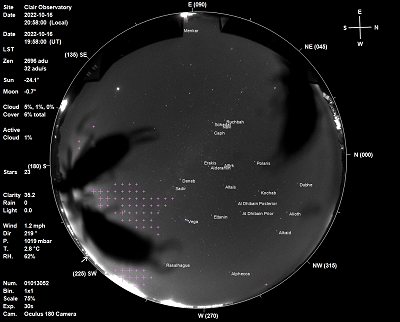
Shining a torch into the hemisphere makes then run back into the camera
housing.
Rather than take the camera down from its mast and open the camera body, it was decided to unscrew the polycarbonate hemisphere and drop into some earwig/woodlice killing powder, taking care not to get the powder on the fish-eye lens.
Whilst this seems to have resolved the problem (no earwigs seen in images over last 6-7 days, the powder was put in on a very damp day, and it begun to rain lightly before the hemispshere could be put back on. This led to the entrapment of high humidity air and possible some raindrop water in the hemisphere when it was closed, and led to an issue with very significant dew formation on the inside surface of the polycarbonate hemisphere. See AllSky Camera - Dew Problem, 2022-10-22.
Back to Top
AstroSuite Programs are being gradually migrated to Target .Net Framework 4.8. The programs migrated so far are:
Notes:
AstroObsCam.
An attempt was made to
move AstroObsCam to 4.8 framework (2022-10-17, v1.10) but program crashed
when trying to connect to Camera, so reverted to target .Net Framework 4.
Same problem when trying to target .Net Framework 4.5. It is supposed
that use of 'DirectShowLib-2005.dll' is preventing a successful migration.
Getting runtime version from 'Reflection.Assembly.ReflectionOnlyLoadFrom("C:\More
Programs\AstroObsCam\DirectShowLib-2005.dll").ImageRuntimeVersion'
indicates that the Net Framework version for the .dll is "v2.0.50727".
AstroMain
The issue with AstroObsCam
provides a warning for AstroMain 3.56 which uses various .com and .dll
components and might run into issues when running a live session.
Although AstroMain was rebult after changing the target .net framework to
4.8, a query using Reflection.Assembly. returns Net Framework version of
v4.0.30319
System.Data.SQLite.dll also returned a Net Framework version
of v4.0.30319.
AstroPlan
AstroPlan /
SqLite : examine :
https://system.data.sqlite.org/index.html/doc/trunk/www/downloads-unsup.wiki
Back to Top
Whilst testing operation of new facility that allows power to the SBIG Camera to be turned off / on my means of a REST API call to deCONZ some observations were made:
1) After switching off SBIG Camera Power whilst CCDSoft is connected to camera
1a) then attempting to take an image from CCDSoft Camera Control produces
a CCDSoft Error Dialog
SBIG driver: Operating system
error.
Error code = 1032
1b) A 'Connect Camera' from AstroMain seems to execute without a problem
and implies that the Camera is connected when it is really unconnected.
CCDSoft likewise implies that the Camera is still connected
1c) If Camera is then disconnected from the CCDSoft Camera Setup,
AstroMain think's that it is still connected. ObsMonitor's
attempts to get Camera informature causes CCDSoft Camera setup to display
'Attempting Connnection' status message each time that camera information is
queried.
1d) When Camera is disconnected in AstroMain, and then a
fresh attempt is made to Connect Camera from AstroMain, it reports
'Connecting Camera Fail SBIG Driver: Device not
found'
1e) When an attempt is made to take an image (3s snap) from AstroMain, an
SBIG driver error is reported.
'Command
failed. Error code = 206 (0xce)'
1f) When an attempt is made to Connect Camera from CCDSoft Camera Setup a
CCDSoft Error Dialog is shown
SBIG driver: Device not
found
Error code = 1027 (0x403).
Same
error dialog is shown when a fresh attempt is made to take an image from
CCDSoft Camera Setup
2) After switching SBIG Camera Power back on
2a) 'Connect' operation from CCDSoft Camera Setup successfully works to
connect with Camera
3) WIth SBIG Camera on and Connected
3a) 20s Snap frame started from AstroMain, and whilst exposure was being
taken, 'RestartCCDSoft' was initiated:
AstroMain crashed with
'System.NullReferenceException: 'Object variable or With block variable not
set.' at globals line 30931 in catch section of TakeImage() at code
line Camera.AutoSaveOn = 1 . The catch section contains
several references to the Camera object, and the Camera object has
become set to Nothing, so the code line line produces the exception which is
not longer caught and the exception bubbles up to the point that it causes
the program to crash
Back to Top
I've previously created a prototype web app 'Observatory Alarms' ( http://www.astro-richweb.net/astro/session_alarm.htm ) for broadcasting alarms and alerts from the Observatory to a web browser (running on a Windows PC or IPAD), but found it impractical to use IPAD for running the web app at nightime, as the IPAD needs to be left running continuously and seemingly left with the web app on the browsers active tab.
In looking for a possible solution I began looking at some other means
like a wifi based alarm or speaker system. A significant issues with using
an alarm like an alarm siren is that they are typically much too loud and
also the available sounds are limited. A speaker system would need to
be WI-FI based and not bluetooth based, and the cost for such a speaker is
quite high (all the cheap speaker systems are bluetooth based it seems).
It then occurred to me that by utilising an existing (but little used)
Google Home speaker I could use it to automatically play alarms & alert
sounds by casting the audio from by Observatory Alarms web app running in
Chrome on the Observatory Computer. Casting from the
Observatory Alarms web app to Google Home, would mean access to a completely
customizable range of suitable alarm/alert sounds, with a volume much more
suited for nighttime / bedroom. Other benefits from the Casting method is
that the existing system for sending events, alerts and alarms from the
Observatory would be essentially unchanged, and there would be no new outlay
for a network connected alarm or speaker.
Development Computer Test
Initial
test using Chrome on the Development Computer showed this Casting method is
feasible. Volume control on the Computer can be on mute (or zero volume) and
the audio still plays on the Google Home speaker.
Observatory Computer Test
Google Chrome
was then downloaded and installed on the Observatory Computer. Then
Opened 'Observatory Alarms' web app in Chrome, cast the page to Google Home
speaker, and began a test alarm. The alarm audio was successfully cast
to the speaker in the house.
Actions
-
![]() Install chrome onto Observatory Computer
Install chrome onto Observatory Computer
-
![]() Set 'session_alarm.htm' as the home (start) page on Chrome browser and set
Cast button to Always Show
Set 'session_alarm.htm' as the home (start) page on Chrome browser and set
Cast button to Always Show
-
![]() Add checkbox option to launch Google Chrome from AstroLaunch
Add checkbox option to launch Google Chrome from AstroLaunch
-
![]() Install 64-bit version of chrome onto Development Computer instead of the
existing 32-bit version.
Install 64-bit version of chrome onto Development Computer instead of the
existing 32-bit version.
-
![]() Make 'session_alarm' chromecast enabled
Make 'session_alarm' chromecast enabled
(look at
https://stackoverflow.com/questions/44999267/how-to-chromecast-enable-a-website
and at
https://developers.google.com/cast/docs/overview )
This seems difficult to do and requires registration, a fee?, https:
Attempt to use basic method didn't seem to work and broke the webapp so
removed again
Workaround is to Cast and then
right-click on Cast Button and enable the Always Show Icon button.
And then remember to manually click Cast button after Chrome starts up
-
![]() Create a clever means to quickly accept an alarm once woken in order to turn
off an alarm sound
Create a clever means to quickly accept an alarm once woken in order to turn
off an alarm sound
-
![]() If the method is successful consider the purchase of a Nest Mini (£49) or a
Lenova Smart Clock Essential with Google Assistent (£40)
If the method is successful consider the purchase of a Nest Mini (£49) or a
Lenova Smart Clock Essential with Google Assistent (£40)
-
![]() Create a backdoor means to enable AstroGuard to post an alarm for the Web
App if AstroMain stops responding.
Create a backdoor means to enable AstroGuard to post an alarm for the Web
App if AstroMain stops responding.
Accepting Alarm Options
- Open IPAD,
Open VNC Connection to Observatory Computer, Click on Accept/Snooze.
- Lower Audio on Google Speaker / Go to Silent and wait for Alarm to
timeout.
- Employ a Zigbee Switch to communicate to the Observatory
Computer to send an "accept" notification to the web site that is then read
by the web app which acts upon the notification and accepts the alarm (which
stops the audio sound coming to the speaker).
Tests
Tests show that my solution works.
- For implementation the alarm/alert sounds coming from the speaker
needs to be loud enough to wake me, but not loud enough or long enough to
wake /disturb my wife as that will lose me any and all spousal approval
points. The volume of Google Home speaker (which would be positioned closer
to me) is adjustable so can I set it with low volume to start with and see
how it goes.
The Web App has snooze and accept buttons to turn off
or defer the alarm sound, and I whilst I can open my IPad and open a vnc
connection go to Chrome and read the alarm/alert message and accept it. I
could look at look into using a zigbee switch beside by bed that can get a
accept/snooze trigger back to my AstroMain program on the Observatory
Computer and from there get a notification to the web app to stop playing
the alert audio. Meanwhile I could open IPad and open web app from there to
read the alert/alarm message and decide what to do.
I was worried
that the instigation of a Hey Google conversation or the activation of an
alarm set separately in Google Home /on through Google assistant might turn
off the Cast from my WebApp but this doesn’t seem to be a problem in the
tests I’ve carried out.
- Saying ‘Hey/Ok Google, stop cast’
stops the Observatory Alarms cast.
(but I have to go back on to
Observatory Computer / Chrome and click Cast button again)
- Saying ‘Hey
Google, play last cast’ gets the response ‘Alright check out this Music
station on YouTube Music’
- Saying ‘Hey Google, pause cast’
does nothing
- Saying ‘Hey Google, start cast’ gets the response
‘Sorry, power control is not supported yet’
- Saying ‘Hey Google,
play cast’ gets the response ‘Playing some music on spotify’
- Saying 'Hey Google, silent' suspends the cast
- Saying 'Hey
Google, continue' resumes the cast
- Saying 'Hey Google,
resume' resumes the cast
Best Option
- Touching the top of Google Home speaker and then saying
"Silent" suspends the cost
- Touching the top of Google Home
speaker and then saying "Continue" or "Resume" resumes the
cost
Back to Top


Back to Top
Pictures illustrating current level of integration :
Device Control
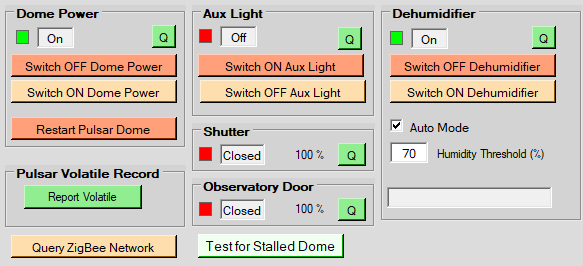


Controls were later extended to include control for
AllSky Dew Heater on 2022-11-14 :
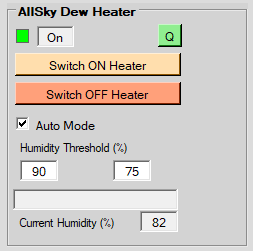
Observatory Status Picture
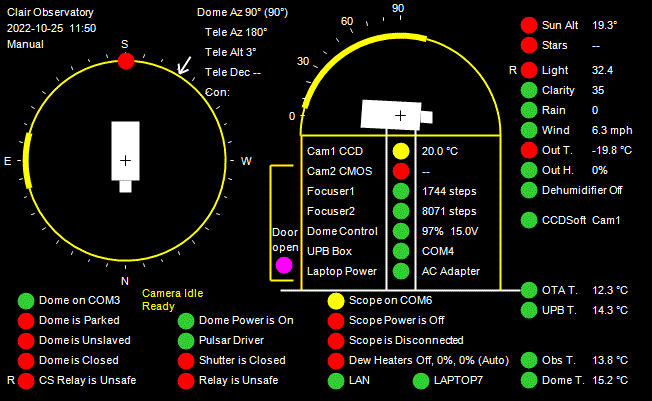
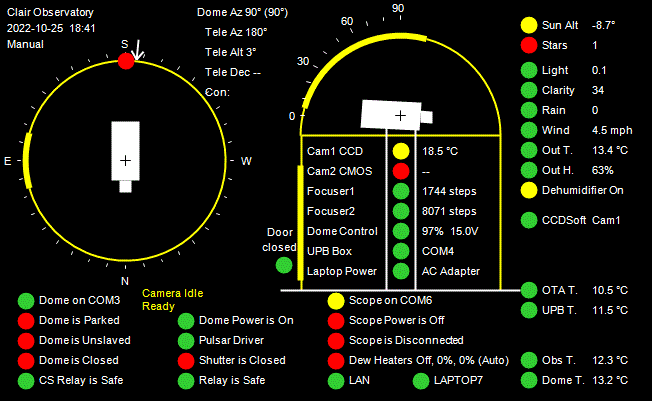
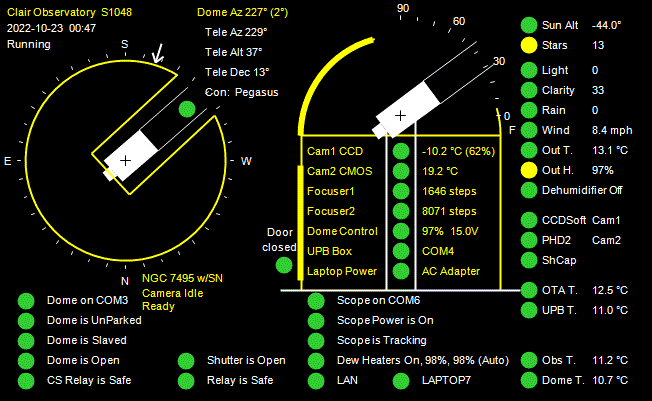
Back to Top
Issue : Firmware on Conbee II USB stick were accidently
corrupted through an attempt to running newly installed ZShark software
(2022-10-22).
Description
ZShark
(win/zshark_V1_0501.exe) was installed on the Observatory Computer with the
aim of eventually using it to sniff out the button event numbers associated
with a future 4 button smart remote controller. After innitial attempt
to run the ZSHark program failed (itw would find the Conbee II device). It
was thought thise might be because deCONZ was running so after closing
deConz a second attempt was made. ZShark indicated that the device on
COM7 occupied by the Conbee 2 USB Stick) was missing firmware and asked to
proceed to install firmware. With no more than a slight though
that this was probably something zShark needed to add, 'OK' was clicked and
something was presumably installed on the Conbee II.
This proved to
be a major mistake, whilst ZShark appear to then connect and at least 2
packages were passed, I was left unsure what I needed to do next and
resigned myself that I would need to look at setup / running of zshark in
more detail and closed the program. deCONZ was restarted but it fail
to connect to the Conbee 2 device.
Multiple attempts were tried to
connect. Including removal and reinserting of the USB stick. With
deCONZ is running but apparently not conneced to the Conbee II device, REST
API (Get) calls seem to superficially work (they return values from when the
Conbee II was last working) but REST API (Put) give an httpResponse
containing an error of type 901 (Intenal error 951).
So it seems
that the firmware on the Conbee 2 has become corrupted and prevents the use
of the Observatory's Zigbee Network until the necessary firmware is
reinstalled on the Conbee II. It is likely that the network devices (Smart
Plugs and Open/Close Sensors) will have to be potentiallly all reset
and re-attached to the network. It is unclear if back-up made earlier
in Phoscon will allow the process to be shortened the process.
Firmware Reinstall
The method used to reinstall firmware is based on
that presented at
https://flemmingss.com/how-to-update-conbee-conbee-ii-firmware-in-windows-10/
Back to Top
| This Web Page: | Notes - Session 1047 (2022-10-14) |
| Last Updated : | 2024-03-27 |
| Site Owner : | David Richards |
| Home Page : | David's Astronomy Web Site |